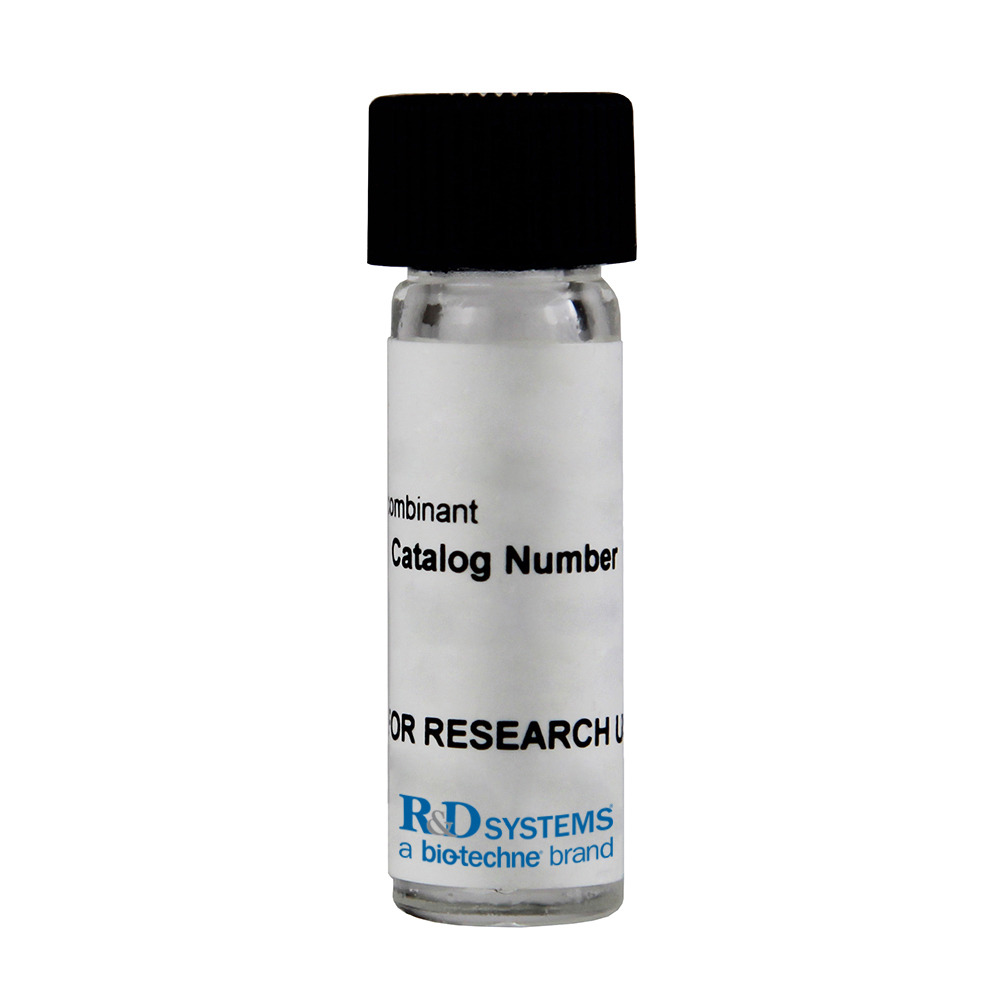Recombinant Mouse Lymphotoxin beta R/TNFRSF3 Fc Chimera, CF
Recombinant Mouse Lymphotoxin beta R/TNFRSF3 Fc Chimera, CF Summary
Product Specifications
8884-LY).
| Mouse Lymphotoxin beta R (Ser28-Pro218) Accession # P50284 |
IEGRMDP | Mouse IgG2A (Glu98-Lys330) |
| N-terminus | C-terminus | |
Analysis
Product Datasheets
Carrier Free
CF stands for Carrier Free (CF). We typically add Bovine Serum Albumin (BSA) as a carrier protein to our recombinant proteins. Adding a carrier protein enhances protein stability, increases shelf-life, and allows the recombinant protein to be stored at a more dilute concentration. The carrier free version does not contain BSA.
In general, we advise purchasing the recombinant protein with BSA for use in cell or tissue culture, or as an ELISA standard. In contrast, the carrier free protein is recommended for applications, in which the presence of BSA could interfere.
1008-LR
| Formulation | Lyophilized from a 0.2 μm filtered solution in PBS. |
| Reconstitution | Reconstitute at 100 μg/mL in PBS. |
| Shipping | The product is shipped at ambient temperature. Upon receipt, store it immediately at the temperature recommended below. |
| Stability & Storage: | Use a manual defrost freezer and avoid repeated freeze-thaw cycles.
|
Reconstitution Calculator
Background: Lymphotoxin beta R/TNFRSF3
Lymphotoxin beta R (LT beta R), previously called TNF RIII or TNF R‑related protein (TNF Rrp), is a type I transmembrane glycoprotein within the TNF receptor superfamily, designated TNFRSF3 (1, 2). Mouse LT beta R cDNA encodes 415 amino acids (aa) including a 30 aa signal peptide, a 193 aa extracellular domain (ECD), a 21 aa transmembrane domain, and a 171 aa cytoplasmic domain. The ECD contains four cysteine‑rich motifs characteristic of the TNF receptor superfamily (1). Within the ECD, mouse LT beta R shares aa sequence identity of 91% aa with rat, and 65-71% with human, canine, porcine, equine and bovine LT beta R. Soluble LT beta R can be formed by proteolytic cleavage of the ECD, and is an inhibitor of transmembrane LT beta R, as is recombinant LT beta R, which inhibits autoimmunity (2-5). A potential mouse isoform that ends at aa 218, just prior to the transmembrane domain, could also be secreted and inhibitory (6). LT beta R is expressed by visceral, lymphoid, and other stroma, epithelia and myeloid cells, but not lymphocytes (1, 3). LT beta R ligands include homotrimers of LIGHT (TNFSF14; also a ligand for HVEM) and the heterotrimeric lymphotoxin LT alpha 1/ beta 2 (2, 3, 5). Depending on the cell type and expression of TRAF3, activation of LT beta R has been shown to induce canonical (IKK/RelA; pro‑inflammatory) or alternative (NIK/RelB; lymphoid organogenic) NF kappa B activation (5, 7). LT beta R is expressed on mesenchymal stromal organizing cells that give rise to stroma of primary (thymus), secondary (tonsils, lymph nodes and Peyers patches) and tertiary (ectopic inflammatory) lymphoid structures (2-4, 8-10). Secondary immune tissues are absent in LT beta R‑deficient mice (2-4). LT beta R engagement induces production of IL‑7, RANK, TRANCE/RANK L, VEGF‑C, adhesion molecules such as VCAM‑1, ICAM‑1 and MAdCAM, and chemokines such as CXCL13, CCL19 and CCL21 (2, 8-10). LT beta R is expressed by hepatocytes, is up-regulated in regeneration, hepatitis and hepatocellular carcinoma, and influences lipid metabolism and atherosclerosis (3, 5, 11). It regulates cell growth and can initiate inflammation‑related carcinogenesis (5, 11).
- Force, W.R. et al. (1995) J. Immunol. 155:5280.
- McCarthy, D.D. (2006) Immunol. Res. 35:41.
- Tumanov, A.V. et al. (2007) Curr. Mol. Med. 7:567.
- Boehm, T. et al. (2003) J. Exp. Med. 198:757.
- Wolf, M.J. et al. (2010) Oncogene 29:5006.
- Entrez Accession # AAA81334.
- Bista, P. et al. (2010) J. Biol. Chem. 285:12971.
- van de Pavert, S.A. et al. (2010) Nat. Rev. Immunol. 10:664.
- Mouri, Y. et al. (2011) J. Immunol. 186:5047.
- Vondenhoff, M.F. et al. (2009) J. Immunol. 182:5439.
- Haybaeck, J. et al. (2009) Cancer Cell 16:295.
Citations for Recombinant Mouse Lymphotoxin beta R/TNFRSF3 Fc Chimera, CF
R&D Systems personnel manually curate a database that contains references using R&D Systems products. The data collected includes not only links to publications in PubMed, but also provides information about sample types, species, and experimental conditions.
2
Citations: Showing 1 - 2
Filter your results:
Filter by:
-
Oxysterol Sensing through the Receptor GPR183 Promotes the Lymphoid-Tissue-Inducing Function of Innate Lymphoid Cells and Colonic Inflammation
Authors: J Emgård, H Kammoun, B García-Cas, J Chesné, SM Parigi, JM Jacob, HW Cheng, E Evren, S Das, P Czarnewski, N Sleiers, F Melo-Gonza, E Kvedaraite, M Svensson, E Scandella, MR Hepworth, S Huber, B Ludewig, L Peduto, EJ Villablanc, H Veiga-Fern, JP Pereira, RA Flavell, T Willinger
Immunity, 2018-01-16;48(1):120-132.e8.
Species: Mouse
Sample Types: Whole Cells
Applications: Flow Cytometry -
Identification and distribution of developing innate lymphoid cells in the fetal mouse intestine.
Authors: Bando J, Liang H, Locksley R
Nat Immunol, 2014-12-15;16(2):153-60.
Species: Mouse
Sample Types: Whole Cells
Applications: Flow Cytometry
FAQs
No product specific FAQs exist for this product, however you may
View all Proteins and Enzyme FAQsReviews for Recombinant Mouse Lymphotoxin beta R/TNFRSF3 Fc Chimera, CF
There are currently no reviews for this product. Be the first to review Recombinant Mouse Lymphotoxin beta R/TNFRSF3 Fc Chimera, CF and earn rewards!
Have you used Recombinant Mouse Lymphotoxin beta R/TNFRSF3 Fc Chimera, CF?
Submit a review and receive an Amazon gift card.
$25/€18/£15/$25CAN/¥75 Yuan/¥2500 Yen for a review with an image
$10/€7/£6/$10 CAD/¥70 Yuan/¥1110 Yen for a review without an image


